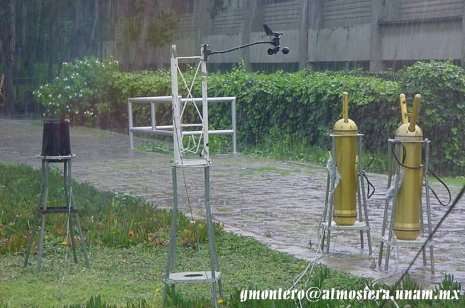Falling faster—researchers confirm super-terminal raindrops

Five years ago, a research team at Michigan Technological University and Universidad Nacional Autanoma de Mexico (National University of Mexico) detected tiny, super-fast raindrops. The finding was unexpected—small drops fell much faster than expected—and now this unexpectedly fast-falling rain has been verified.
Not only do these small raindrops fall faster than expected, they fall faster than they should be able to alone. As an object falls, two forces clash: Gravity pulls it down while air resists. Where the force of gravity matches the force of air resistance, the object reaches its "terminal speed." While the name sounds final, it's not. These small raindrops move faster—they are "super-terminal" raindrops.
Study co-author Alex Kostinski, a professor of physics at Michigan Tech, says confirming the speed was exciting, but not the most surprising result.
"What was so surprising was just how many drops violated the speed limit, so to speak," he says.
Over five months, the research team found super-terminal raindrops in all six rain storms they studied at a site just outside Charleston, S.C. Of the 1.5 million raindrops measured, all drops 0.8 mm and larger fell at expected speeds—and for drops sized 0.3 to 0.8 mm, 30 to 60 percent of them fell at super-terminal speeds.
To detect and measure the falling rain, the team used 22 instruments that optically track each drop as it passes through a laser beam. The equipment was crucial for ruling out instrument error and splashing as the source of the speedy drops.
Lead author Michael Larsen, an assistant professor of physics and astronomy at the College of Charleston, designed the experiment set-up. A Michigan Tech alumnus and former doctoral student of Kostinski's, Larsen says working on this research has helped "recapture some of the magic" of his graduate studies.
"The fact that a substantial fraction of drizzle-sized drops are moving faster than their terminal velocities suggest that we are not just seeing an outlier effect here," Larsen says. "That was a bit surprising to me and helped me realize that there's more science to be done."
With instrumental error ruled out, figuring out how to plug super-terminal drops into existing calculations may change rainfall estimates and erosion impacts. To do so calls into question a base assumption of many models. Kostinski says he is amazed "the assumption that rain consists of single, isolated drops, falling at prescribed speeds, has lasted so long," explaining that this assumption is deeply embedded in atmospheric science.
The quantitative extent of super-terminal raindrops' impact is yet unknown. And before calling to rewrite a bunch of calculations, Kostinski and Larsen want to figure how the drops form in the first place. One possibility is that the super-terminal rain breaks off of larger drops.
"Collisions may be very important, and rain may be more agitated than we think," says Kostinski, explaining the shape of falling raindrops. Certainly more restless than the endearing tear-shaped icon, falling raindrops are actually distorted spheres—flat on the downside, wobbling like a bowl of jello above. Caught between gravity and air resistance, the raindrops may break up and Kostinski explains, "As larger drops break up, fragments move at unexpected speeds."
Unexpected but now measured, verified and ready to be explored.
Provided by Michigan Technological University



















